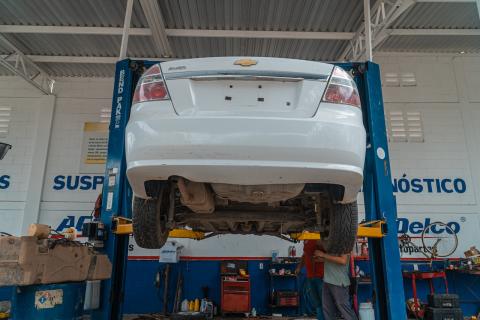
Industrial lift systems have changed the way we work. Aside from making it easier to move materials up and down, lifts have also increased productivity, protected workers from injuries, and even cut production costs. Here, we take a closer look at two of the most common lift systems for industrial project management: hydraulic and pneumatic lifts.
Hydraulic lift systems
From its name, a hydraulic lift system uses a mechanism that compresses a form of liquid like oil to generate linear motion that helps to raise or lower the platform where you're placing the object. Hydraulic lift systems are generally more potent than pneumatic ones, which is why they're used more in industrial spaces and workshops where there's a need to lift hefty objects.
You'll see hydraulic lift systems in applications such as car lifts, dump truck lifts, wing flaps on an aircraft, forklifts, and turbines. Most elevators also use a hydraulic lifting mechanism because it can take on heavier loads.
One of the most significant benefits of using hydraulic lift systems in industrial project management is that it promotes the safety of employees. Depending on your needs, you can customize these hydraulic lifts to be as big or small so that they fit in your space perfectly and not make your area look cluttered. Hydraulic lifts are also very convenient, even for beginner workers, and they can load and unload objects fast.
Pneumatic lift systems
Pneumatic lifts work through a piston and hollow cylinder where an external pump or motor forces air pressure to allow it to move up and down in lifting components. One of the most significant advantages of using pneumatic lift systems is their versatility. Since it doesn't require electricity to work, you can use it for a wide variety of applications, whether indoors or outdoors. You can also expose pneumatic lifts to extreme weather conditions, and you won't have a problem since they don't need any electric power to function.
Pneumatic lift systems are also less expensive upfront than hydraulic systems. However, it would be best if you kept in mind that since they need consistent pressure to operate efficiently, the running costs of operating them can make them more expensive than hydraulic lifts. Pneumatic lifts also have limitations in their applications since they can't carry heavy loads as compared to hydraulic lift systems that have more power for bigger applications.
Investing in the Right Lift Systems
Both hydraulic and pneumatic lift systems have been proven efficient in different applications. Whether to invest in a hydraulic or pneumatic lift for your industrial project management will depend on your needs, type of operations, and of course, budget. So, make sure you create a list of requirements before you start looking for options - or get help from a professional. This way, you can guarantee that you're investing in a lift system that will be beneficial for your business.
Although a wide variety of companies produce high-quality hydraulic equipment for use in these environments, the name Presto Lifts is worthy of special consideration. This is one of the many respected and high-quality companies Steinco Industrial Solutions offers as a wholesale supplier of the best industrial products! Contact Steinco Industrial Solutions to learn more and get the help that you need!
